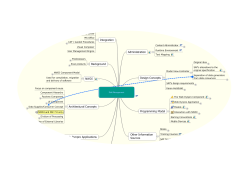As a member of PM PM SIG group, I recently attended breakfast session on Using Mind Maps for Risk Management. The presentation was good. It would have been even better if presenter’s brand new laptop worked to display his slides/Mind Map templates. We ended up spending quite a bit of time out of an hour long session to fix his laptop problem. I even heard a comment from somebody in back…”talk about risk management…” ![]() Still, I thought the talk was pretty good and found presenter very enthusiastic to present the topic. I found it interesting and it made me think about how one can use Mind Map for Risk Management on different projects.
Still, I thought the talk was pretty good and found presenter very enthusiastic to present the topic. I found it interesting and it made me think about how one can use Mind Map for Risk Management on different projects.
How can we use Mind Map for Risk Management? First, let’s briefly talk about Mind Maps. What is Mind Map? Mind map is a graphical network diagram with nodes or branches. It is laid out using different colors, and icons to help convey an idea. Mind Map can be very useful for brainstorming activity, hence they are often called brainstorm maps, are illustrated views of an idea. One of the most popular commercial Mind Map tools available is MindManager. We will use it for the purpose of discussion.
According to PMBOK, Time, Cost and Scope are three components of Triple Constraints. Risk has the potential to affect all of them. It’s critical to manage risk as part of overall Project Management. That means identifying a set of processes for risk management that includes planning, identification, analysis, response, monitoring and control.
Mind Maps can be especially used for risk identification. The iterative nature of the risk identification process makes it a perfect candidate for mind maps. Note that it is also nonlinear as it is being done continuously during various phases. A risk may turn into other identified risks. It can be difficult to track them and express relationships between them as risk log evolves. During brainstorming session, project manager encourages team members to identify risks and uses a mind map to capture them and generates new ideas from the team. Again, this will be an iterative process and mind map for risk will evolve over the time. Over the time, relationships and dependencies evolve for various risks and are represented using nodes and arrows in mind map.
Later on, this mind map can be utilized for subsequent processes of Risk Management as well and can be extended to include risk response strategies, impact analysis,etc.
In summary, the mind map enables brainstorming, relationship and prioritization of risks in graphical form (picture is worth 1000 words). It also helps to categorize project risks into the time, scope and resource categories. The mind maps present unique opportunity for project manager to mange risk effectively.


Kuntal,
I have been using mind maps for years, sometimes you the group looks at you like you are some kind of witch doctor when I put up a mind map! But after a few minutes they see the benefits.
Mind maps can absolutely be used in risk management, especially to capture risk and group them into themes.
My blog article covers my thoughts on project risk management http://strikingprojectmanagement.com/project-management/management-of-risk-in-projects/
Great article Kuntal. Thanks for taking the time to capture your thoughts.
Thanks for your input, Josh. Yes, 5-why’s could be useful to find root causes of some problems. XMind is good alternative to Mind Manager, especially, in startup environment where revenue might not have started streaming and cost and time are of utmost importance.
Great post, another use is to extend the branches out for a 5-why’s analysis when trying to uncover root causes of risks. (Sometimes it will be best to have separate files rather than try to do all this in one)
I recently discovered XMind, which is a lot like MindManager only XMind is open source and free to use! There’s a pro version with more collaboration features, but the free version is fully functional for most purposes.
Incidentally, 3 of the tutorials from lesson 5 of my WBS training course demonstrate different mind mapping tools. It’s really great for the work breakdown structure too. (I love mind mapping!)
Josh Nankivel
pmStudent.com